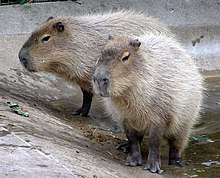Hydrochoerinae is a subfamily of Caviidae, consisting of two living genera, Hydrochoerus, the capybaras, and Kerodon, the rock cavies. In addition, a number of extinct genera related to capybaras should also be placed in this subfamily. The taxonomy of Hydrochoerinae is confused because, until 2005, living capybaras and their extinct relatives were placed in their own family, Hydrochoeridae.[1] Recent molecular phylogenetic studies recognize a close relationship between Hydrochoerus and Kerodon,[2] supporting placement of both genera in a subfamily of Caviidae.[3] Paleontological classifications have yet to incorporate this new taxonomy, and continue to use Hydrochoeridae for all capybaras, while using Hydrochoerinae for the living genus and its closest fossil relatives such as Neochoerus.[4][5] The taxonomy of fossil hydrochoerines is also in a state of flux. In recent years, the diversity of fossil hydrochoerines has been substantially reduced.[4][5][6] This is largely due to the recognition that capybara molar teeth show strong variation in shape over the life of an individual.[4] In one instance, material once referred to four genera and seven species on the basis of differences in molar shape is now thought to represent differently aged individuals of a single species, Cardiatherium paranense.[4]
| Hydrochoerinae Temporal range:
| |
|---|---|

| |
| Capybara | |
| Scientific classification | |
| Domain: | Eukaryota |
| Kingdom: | Animalia |
| Phylum: | Chordata |
| Class: | Mammalia |
| Order: | Rodentia |
| Family: | Caviidae |
| Subfamily: | Hydrochoerinae J. E. Gray, 1825 |
| Genera | |
References
edit- ^ McKenna, Malcolm C., and Bell, Susan K. 1997. Classification of Mammals Above the Species Level. Columbia University Press, New York, 631 pp. ISBN 0-231-11013-8
- ^ Rowe, D. L.; Honeycutt, R. L. (2002). "Phylogenetic relationships, ecological correlates, and molecular evolution within the Cavioidea (Mammalia, Rodentia)". Molecular Biology and Evolution. 19 (3): 263–277. doi:10.1093/oxfordjournals.molbev.a004080. ISSN 0737-4038. PMID 11861886.
- ^ Woods, C.A.; Kilpatrick, C.W. (2005). "Infraorder Hystricognathi". In Wilson, D.E.; Reeder, D.M (eds.). Mammal Species of the World: A Taxonomic and Geographic Reference (3rd ed.). Johns Hopkins University Press. pp. 1555–1556. ISBN 978-0-8018-8221-0. OCLC 62265494.
- ^ a b c d Vucetich, M. G.; Deschamps, C. M.; Olivares, A. I.; Dozo, M. T. (2005). "Capybaras, size, shape, and time: A model kit". Acta Palaeontologica Polonica. 50 (2): 259–272. Retrieved 2012-05-21.
- ^ a b Deschamps, C. M.; Olivares, A. I.; Vieytes, E. C.; Vucetich, M. G. (2007-09-12). "Ontogeny and diversity of the oldest capybaras (Rodentia: Hydrochoeridae; late Miocene of Argentina". Journal of Vertebrate Paleontology. 27 (3): 683–692. doi:10.1671/0272-4634(2007)27[683:oadoto]2.0.co;2. JSTOR 30126368. S2CID 86217854.
- ^ Prado, J. L.; Cerdeño, E.; Roig-Juñent, S. (1998-12-28). "The giant rodent Chapalmatherium from the Pliocene of Argentina: New remains and taxonomic remarks on the Family Hydrochoeridae". Journal of Vertebrate Paleontology. 18 (4): 788–798. Bibcode:1998JVPal..18..788P. doi:10.1080/02724634.1998.10011107. JSTOR 4523956.